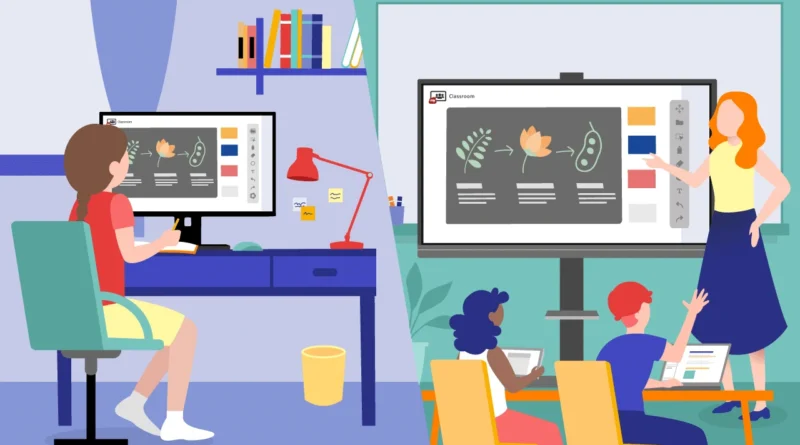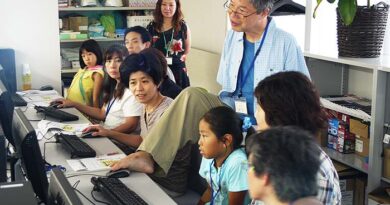Blended Learning with ICT: Revolutionizing Education
Revolutionizing Education: The Power of Blended Learning with ICT
Introduction
Definition of Blended Learning with ICT
Blended learning with ICT is a modern approach to education that combines traditional classroom teaching with the use of technology. It involves the integration of online resources, digital tools, and multimedia elements into face-to-face instruction. In other words, it is a hybrid form of education that combines the best of both worlds: the efficiency and flexibility of online learning and the personal interaction and engagement offered by traditional teaching methods.
Explanation of Why It Is Important in the Current Educational Landscape
In today’s world, technology has become an integral part of our daily lives, including in education. With more advanced tools and resources available than ever before, we are now able to use technology to enhance teaching and learning in ways that were once impossible.
Blended learning with ICT allows for more personalized instruction, improved accessibility for students who may not have access to traditional classroom settings or who require flexible schedules due to work or family commitments. Furthermore, blended learning with ICT provides opportunities for collaboration between teachers and students from different locations around the world.
This is especially relevant in our current globalized society where individuals need to be prepared for working in diverse environments within a constantly evolving technological landscape. Therefore, blended learning provides a gateway for learners worldwide to keep up with technological advancements while embracing diversity as well as personalization in their educational experience.
The Basics of Blended Learning with ICT
Overview of the Different Models and Approaches to Blended Learning
Blended learning with ICT is a teaching and learning approach that combines traditional face-to-face instruction with online or digital resources. It can be organized in a variety of ways depending on the needs and goals of the learners, teachers, and administrators. Some examples of blended learning models include rotation, flex, self-blend, enriched virtual, and online lab.
The rotation model involves students rotating between different modes of instruction such as working in small groups or completing individual activities using technology. The flex model allows students to have more control over when, where, and how they learn by providing them with a range of options for accessing resources based on their learning styles and preferences.
The self-blend model is similar to the flex model but gives students even more autonomy by allowing them to choose which courses or subjects they want to study online versus in person. Enriched virtual models combine both face-to-face class time with online coursework for a more seamless experience while the online lab model involves students working entirely from home but still receiving support from a teacher.
Explanation of How Technology Can Be Integrated into Traditional Classroom Settings
Integrating technology into traditional classroom settings can provide many benefits for both teachers and learners. Teachers can use technology to enhance student engagement by incorporating interactive multimedia such as videos or animations into their lessons.
They can also use tools like digital whiteboards or polling software to gather feedback from their students in real-time. Furthermore, technology can help facilitate communication and collaboration among learners by allowing them to work together on projects using cloud-based software or participate in discussions through an online platform.
It also provides flexibility for learners who may need additional time or different types of resources to achieve their academic goals. Technology integration doesn’t have to be complicated either!
Simple solutions such as using a learning management system or providing students with access to educational apps and games can make a big difference. By incorporating technology into traditional classroom settings in meaningful ways, teachers and learners alike can reap the many benefits of blended learning with ICT.
Advantages and Benefits of Blended Learning with ICT
Improved Student Engagement and Motivation
One of the biggest advantages of blended learning with ICT is that it can increase student engagement and motivation in the classroom. Gone are the days when students would simply sit in a lecture hall, listen to a teacher drone on, and then take notes.
With technology integrated into the classroom, students can now interact with digital tools that make learning more interactive, fun, and engaging. For example, teachers can use virtual simulations or games to teach complex concepts such as physics or chemistry.
Gamification techniques such as leaderboards can motivate students to compete with each other for high scores which encourages them to learn more. Moreover, using videos or online resources in class enables teachers to create a more dynamic environment that caters better to different types of learners.
Enhanced Flexibility and Accessibility for Learners
Another key advantage of blended learning with ICT is that it provides learners with enhanced flexibility and accessibility. With traditional forms of education like lectures or textbooks, learners are tied down by time constraints and physical locations. Blended learning allows learners to access resources online at any time they choose; they can pause lessons if they need a break or go back over material until they understand it fully without worrying about falling behind others in their class.
This flexibility makes blended learning ideal for adults who may have busy schedules but still want to learn new skills. By providing content online as well as in-person instruction on campus (or off), blended learning also helps make education accessible to those who cannot attend school due to financial constraints or geographical distance.
Increased Collaboration and Communication Among Students and Teachers
Blended learning fosters increased collaboration between students themselves as well as between students and teachers outside the physical classroom walls. Collaboration tools such as discussion forums facilitate rich conversations between students, allowing them to share their thoughts and ideas more easily than in a traditional classroom. Teachers can also use these tools to offer feedback, engage with students and provide support outside of regular class times.
Moreover, online collaboration tools allow teachers in different locations to collaborate on lesson planning and teaching materials. This opens up new possibilities for interdisciplinary courses or even entire programs that are designed to be delivered entirely online.
In sum, the advantages of blended learning with ICT are clear: it engages learners, provides flexibility and accessibility, and encourages collaboration. With these benefits at our fingertips, it’s no wonder blended learning has become an essential part of modern education.
Challenges and Considerations in Implementing Blended Learning with ICT
Technical Issues: Connectivity, Accessibility, and Hardware/Software Compatibility
While blended learning with ICT can be a highly effective way to enhance student engagement and achievement, there are several technical issues that educators must consider when implementing this approach. One of the most significant challenges is ensuring that all students have access to reliable internet connectivity, as well as the necessary hardware and software tools to participate fully in online activities.
This can be especially difficult for schools located in rural or low-income areas where high-speed internet is not readily available. Another issue is ensuring compatibility between different devices and software applications.
Different operating systems, hardware configurations, and software versions can cause compatibility issues that may negatively affect the learning experience for both teachers and students. In some cases, it may also be necessary to invest in new hardware or software solutions to ensure that everyone has access to the necessary tools for blended learning.
Training Teachers Effectively Use Technology in the Classroom
Effective implementation of blended learning with ICT requires that teachers have the skills and knowledge needed to effectively integrate technology into their lesson plans. Many educators may not feel comfortable using technology or lack sufficient training on how best to use it in a classroom setting. As such, providing targeted professional development opportunities for teachers can help overcome this barrier by providing them with the skills they need to use technology effectively.
This training should not only focus on technical skills but also on how best to use technology tools to enhance teaching strategies such as project-based learning, collaborative activities, differentiated instruction among others. Teachers should also learn how best to balance face-to-face instruction with online activities so that students receive the most benefit from both modes of instruction.
Balancing Face-to-Face Instruction With Online Activities
One of the most significant challenges associated with blended learning is finding the right balance between face-to-face instruction and online activities. Too much emphasis on online activities may lead to decreased student engagement, while too much focus on face-to-face instruction can limit the benefits of blended learning with ICT. To overcome this challenge, educators must carefully design blended learning activities that integrate both modes of instruction in a way that promotes active participation and engagement from students.
This requires clear communication with students about how and when they will be expected to participate in both face-to-face and online activities. Teachers should also ensure that all students have access to the necessary technology tools and resources needed to complete their assignments outside of the classroom.
Best Practices for Successful Implementation
Clear Goals and Objectives for Blended Learning Initiatives
When implementing blended learning with ICT, it is important to establish clear goals and objectives that align with the overall educational strategy of the institution. These goals should be specific, measurable, attainable, relevant, and time-bound (SMART).
For example, a goal could be to increase student engagement in math classes by 20% using a blended learning approach within six months. Having clear goals and objectives will help teachers and administrators stay focused on the desired outcomes of their blended learning initiatives.
They can then tailor their teaching methods and technology use accordingly to achieve these goals. Effective communication between all stakeholders is also necessary to ensure everyone is on the same page regarding these objectives.
Effective Communication Between Teachers, Students, Parents, and Administrators
Communication is key when implementing blended learning with ICT. Teachers need to communicate clearly with students about what they are expected to learn and how they will learn it using technology. They also need to provide regular feedback on student progress so that both students and parents are aware of how well they are doing.
Furthermore, administrators need to communicate effectively with teachers so that they understand how their efforts fit into the bigger picture of the school’s educational strategy. This includes providing resources such as training and support for teachers who may not be familiar or comfortable with using technology in their teaching.
Parents should also be informed about what their children are learning in class through regular updates or newsletters from teachers. This ensures that everyone is working towards the same goals for student success.
Regular Assessment and Evaluation to Measure Progress
Assessment is an essential component of any educational program including blended learning with ICT. It allows teachers and administrators to evaluate student progress towards achieving established goals.
Regular assessments help identify areas where students may need additional support or where the blended learning approach may need adjustment. Furthermore, evaluation of the overall effectiveness of blended learning with ICT is also important.
This can be done through surveys or focus groups with students, teachers, and parents. It allows schools to determine the impact of their blended learning initiatives on student learning outcomes and adjust accordingly.
Overall, clear goals and objectives, effective communication and regular assessment and evaluation are essential for successful implementation of blended learning with ICT. With these best practices in place, schools can ensure that their students are receiving high-quality education that prepares them for success in a technology-driven world.
Innovative Uses of Technology in Blended Learning Environments
Virtual Field Trips Using VR Technology
One of the most exciting and innovative uses of technology in blended learning environments is the ability to take students on virtual field trips. With virtual reality (VR) technology, students can explore different parts of the world and even visit inaccessible places such as outer space or deep sea exploration.
The benefits of using VR for field trips are many. First, it provides an immersive experience for students that allows them to better understand the concepts they are learning about.
Second, it is much more cost-effective than traditional field trips, which often involve expensive travel and accommodation costs. Third, it can be used to supplement traditional field trips by allowing students to go on multiple trips throughout the year.
Gamification Techniques to Enhance Learning Outcomes
Gamification techniques involve integrating game-like elements into learning activities to make them more engaging and fun for students. This can include things like points systems, leaderboards, badges, and rewards.
There are many benefits to using gamification techniques in blended learning environments. First, it can help motivate and engage students who may be struggling with traditional teaching methods.
Second, it can encourage healthy competition among peers that helps drive them to perform at their best. Third, it creates a sense of achievement and progress that encourages students to continue learning.
Personalized Learning Paths Using Adaptive Software
Adaptive software is designed to tailor educational content based on a student’s individual needs and preferences. It uses data analysis algorithms that track a student’s performance over time so that it can provide personalized feedback and recommendations for improvement.
The benefits of using adaptive software in blended learning environments are many. First, it allows teachers to provide individualized instruction that addresses each student’s unique strengths and weaknesses.
Second, it promotes self-directed learning by giving students the ability to control the pace and direction of their learning. Third, it can lead to better learning outcomes overall by providing targeted instruction that helps students achieve mastery.
Conclusion
Blended learning with ICT is a dynamic and exciting way to enhance the learning experience for students of all ages. By combining traditional face-to-face instruction with online activities, teachers are able to create a more flexible and engaging learning environment that meets the needs of diverse learners.
Throughout this article, we’ve explored the basics of blended learning with ICT, its advantages and benefits, challenges and considerations in implementation, best practices for success, and innovative uses of technology in blended learning environments. Blended learning with ICT holds immense potential for transforming education.
With technology constantly evolving, it’s important that educators stay current on new tools and trends. By doing so, they can continue to create innovative and effective blended learning experiences that meet the needs of 21st-century learners.
The future outlook for blended learning with ICT is bright; as more teachers embrace this approach, we can expect to see even more exciting developments in the years ahead. So let’s keep pushing boundaries and exploring new ways to leverage technology to improve education for all!



